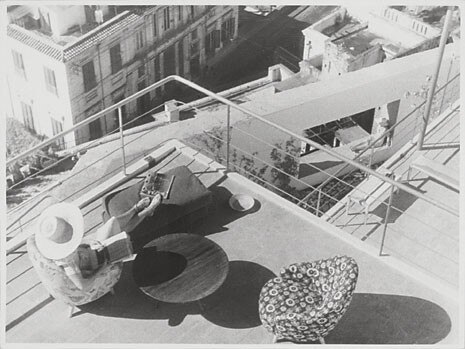An exhibition at the Getty Research
Institute in LA and the companion book
from Birkhauser are both entitled
Lessons from Bernard Rudofsky. They
are as provocative as their subject: a
modernist architect who championed
the vernacular, a wickedly observant
traveller, and an iconoclast with an
original opinion on varied aspects of
design and human behaviour. Like Le
Corbusier, he was a northerner (from
Vienna) who found inspiration in the
south. “The Mediterranean taught
Rudofsky and Rudofsky taught me,”
declared Gio Ponti. “[We] were friends,
designed a great deal together, and built
nothing.” However, they did enjoy a
fruitful collaboration at Domus in 1937-
38, and that gave Rudofsky the
opportunity to express ideas he would
flesh out over the next 50 years.
The exhibition, which was previously
shown at the Architekturzentrum in
Vienna and the CCA in Montreal, has
been compressed to fit the small
galleries of the GRI. Curator Wim de Wit
heeded Rudofsky’s expert advice on
installing a mix of travel sketches,
photographs, plans and documents
from the Getty Archives. There’s a
constant sense of surprise, and the
exhibits are layered over blow-ups that
add another dimension to the display.
Rudofsky was a restless polymath, but
he kept returning to a few basic themes
and the exhibition brings the man and
his work into sharp focus. It portrays
him as a rational sensualist, proposing
buildings and clothes that would protect
the body without imprisoning it.
As a 24-
year-old engineering student, he spent
three months on Santorini preparing his
thesis on concrete vaults, while painting
the cubist hill towns. That experience
launched a life-long pursuit of truth and
beauty in “primitive” buildings. The
photographs he took on his travels
inspired the landmark exhibition and
book, Architecture Without Architects.
First proposed in 1941 to the New York
Museum of Modern Art, which initially
found the idea heretical, it was finally
presented there in 1964. But MoMA was
eager to hire him from the start, and he
began his long association with the
1943 exhibition, “Are Clothes
Modern?”, exposing the absurdities of
fashion, and particularly of conventional
footwear. He created strappy sandals to
liberate the feet and ironically they were
embraced by the fashionistas he had
mocked. One of his 1940s’ designs has
been brought back into production and
still looks timeless. To demonstrate his
concept of healthy living in harmony
with nature, Rudofsky designed a
succession of cubist courtyard houses.
“Architecture is not just a matter of
technology and aesthetics but the frame
for a way of life – and, with luck, an
intelligent way of life,” he declared. The
Casa d’Oro overlooking the Bay of
Naples and the Casa Arnstein in Sao
Paolo have been lovingly preserved. In
Brazil, to which he fled in 1938 to avoid
military service in Nazi-occupied
Austria, and in the US, where he lived
until his death in 1988, he continued to
design houses for himself and others,
but his passion was to challenge
received wisdom. He saw things that
others missed.
Returning to Rome in
1946, he photographed the abandoned
buildings of EUR as though they were
ruins of the ancient world. A two-year
stay in Japan in the late 1950s
generated The Kimono Mind, an
unsparing account of the qualities and
deficiencies of that society.
Rudofsky was born in 1905, and was
under-appreciated during his long and
productive life. The exhibition
demonstrates that his ideas are more
relevant today than ever before. Monika
Platzer, who edited the handsome
companion book, with its scholarly
essays and abundant illustrations,
observes: “[He] was a virtuoso of the art
of living, a non-conformist who resisted
– indeed refused to accept – the
accelerated pace of his time. He was at
home nowhere and everywhere.” Michael Webb
11.03-08.06.2008
Lesson from Bernard Rudofsky
The Getty Research Institute
1200 Getty Center Drive, Suite 1100
Los Angeles, CA 90049-1688
https://www.getty.edu/research/exhibitions/
Domus as a launch pad for an Austrian maverick
An exhibition at the Getty Research Institute in LA and the companion book from Birkhauser are both entitled Lessons from Bernard Rudofsky.

View Article details
- 20 February 2008